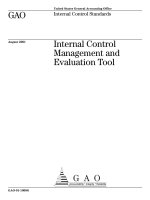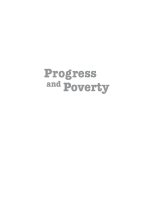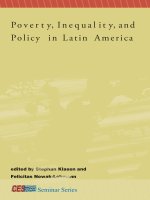Poverty, inequality, and evaluation changing perspectives
Bạn đang xem bản rút gọn của tài liệu. Xem và tải ngay bản đầy đủ của tài liệu tại đây (7.12 MB, 313 trang )
POVERTY,
INEQUALITY,
AND
EVALUATION
POVERTY, INEQUALITY,
AND EVALUATION
Changing Perspectives
Ray C. Rist,
Frederic P. Martin, and
Ana Maria Fernandez,
Editors
© 2016 International Bank for Reconstruction and Development / The World Bank
1818 H Street NW, Washington, DC 20433
Telephone: 202-473-1000; Internet: www.worldbank.org
Some rights reserved
1 2 3 4 18 17 16 15
This work is a product of the staff of The World Bank with external contributions. The findings, interpretations, and conclusions expressed in this work do not necessarily reflect the views of The World Bank, its
Board of Executive Directors, or the governments they represent. The World Bank does not guarantee the
accuracy of the data included in this work. The boundaries, colors, denominations, and other information
shown on any map in this work do not imply any judgment on the part of The World Bank concerning the
legal status of any territory or the endorsement or acceptance of such boundaries.
Nothing herein shall constitute or be considered to be a limitation upon or waiver of the privileges and
immunities of The World Bank, all of which are specifically reserved.
Rights and Permissions
This work is available under the Creative Commons Attribution 3.0 IGO license (CC BY 3.0 IGO) http://
creativecommons.org/licenses/by/3.0/igo. Under the Creative Commons Attribution license, you are free
to copy, distribute, transmit, and adapt this work, including for commercial purposes, under the following
conditions:
Attribution—Please cite the work as follows: Rist, Ray C., Frederic P. Martin, and Ana Maria Fernandez,
eds. 2016. Poverty, Inequality, and Evaluation: Changing Perspectives. Washington, DC: World Bank.
doi:10.1596/978-1-4648-0703-9. License: Creative Commons Attribution CC BY 3.0 IGO
Translations—If you create a translation of this work, please add the following disclaimer along with the
attribution: This translation was not created by The World Bank and should not be considered an official
World Bank translation. The World Bank shall not be liable for any content or error in this translation.
Adaptations—If you create an adaptation of this work, please add the following disclaimer along with the
attribution: This is an adaptation of an original work by The World Bank. Views and opinions expressed in
the adaptation are the sole responsibility of the author or authors of the adaptation and are not endorsed by
The World Bank.
Third-party content—The World Bank does not necessarily own each component of the content contained
within the work. The World Bank therefore does not warrant that the use of any third-party-owned
individual component or part contained in the work will not infringe on the rights of those third parties.
The risk of claims resulting from such infringement rests solely with you. If you wish to re-use a component of the work, it is your responsibility to determine whether permission is needed for that re-use and
to obtain permission from the copyright owner. Examples of components can include, but are not limited
to, tables, figures, or images.
All queries on rights and licenses should be addressed to the Publishing and Knowledge Division, The World
Bank, 1818 H Street NW, Washington, DC 20433, USA; fax: 202-522-2625; e-mail:
ISBN (paper): 978-1-4648-0703-9
ISBN (electronic): 978-1-4648-0704-6
DOI: 10.1596/978-1-4648-0703-9
Cover and interior design: Debra Naylor, Naylor Design, Inc.
Library of Congress Cataloging-in-Publication data has been requested.
CONTENTS
About the Editors
Abbreviations
Introduction
xv
xvii
1
Ray C. Rist
The Premise
Inequality and the Evaluation Literature
Postscript
References
1
2
4
4
Part One: Analytical Framework
7
Chapter 1. Moving the Discussion from Poverty to
Inequality: Implications for Evaluation
9
Paul Shaffer
Introduction: The Return of Inequality
Expanding Dimensions of Deprivation or Social “Bads”
Shifting Causal Analysis to Social Structures and Relationships
Widening Policy Instruments and Programming Options
Conclusion
Notes
References
9
11
14
17
18
19
19
v
Part Two: Empirical Measurement of the Performance and
Results of Poverty and Inequality Reduction
Programs and Projects
23
Chapter 2. Evaluations as Catalysts in Bridging
Developmental Inequalities
25
Rashmi Agrawal and Banda V. L. N. Rao
Introduction
Focus on Equity and Equality in India
Evaluations and Equity Issues
Case Studies from India
Equity Interventions Leading to Lower Inequality
Persistent Inequalities despite Improved Equity
Are Evaluations the Answer to Every Problem?
Conclusion
Notes
References
25
27
28
29
31
33
35
37
37
38
Chapter 3. Evaluating Value Chain Development Programs:
Assessing Effectiveness, Efficiency, and Equity
Effects of Contract Choice
39
Ruerd Ruben
Introduction
Setting the Stage
The Rise of Private Sector Development Programs
Value Chain Development: An Analytical Perspective
Value Chain Impact Analysis: Focus on Development Effectiveness
Value Chain Modeling: Insights in Equity
Contract Choice in Value Chains: Understanding Uncertainty
Conclusions and Outlook
Notes
References
39
40
42
43
46
48
50
53
54
54
Chapter 4. Assessing Growth and Its Distribution in
IFC Strategies and Projects
57
Ade Freeman and Izlem Yenice
Introduction
Poverty Focus at the Strategic Level
Poverty Focus in IFC Projects
vi
57
58
65
Contents
Poverty Outcomes in IFC Projects
Conclusion
Notes
References
68
71
72
72
Chapter 5. Addressing Inequality and Poverty:
An Evaluation of Community Empowerment in Jordan
73
Ann M. Doucette
Introduction
Jordan River Foundation
The Context
Community Empowerment Program
Evaluation Approach
Evaluation Findings
Summary and Conclusions
Notes
References
73
74
75
76
77
84
94
95
96
Chapter 6. Determining the Results of a Social
Safety Net Program in St. Lucia
97
Paulette Nichols, Bobb Darnell, and Frederic Unterreiner
Introduction
Initial Design and Objectives
Beneficiary Households
Evaluation Methodology
Evaluation Findings
Recommendations
Conclusion
Notes
References
97
98
103
104
110
116
118
119
120
Chapter 7. HIV/AIDS Services Delivery, Overall Quality
of Care, and Satisfaction in Burkina Faso: Are Some
Patients Privileged?
121
Harounan Kazianga, Seni Kouanda, Laetitia N. Ouedraogo,
Elisa Rothenbuhler, Mead Over, and Damien de Walque
Introduction
Methods: Sampling and Survey
Data Analysis
Contents
121
123
125
vii
Results
Discussion
Conclusions and Policy Recommendations
Annex 7A Robustness of Multivariate Analysis to an Alternative
Definition of Health Care Quality Index
Notes
References
125
129
132
133
136
137
Chapter 8. A Portfolio Approach to Evaluation:
Evaluations of Community-Based HIV/AIDS Responses
139
Rosalía Rodriguez-García
Introduction
The Global Context of Community Engagement in HIV/AIDS
Why a “Portfolio Approach”
Objectives
Design and Framework
Methodology: A Mixed-Method Approach
Implementing the Evaluation Portfolio: A Phase-in Approach
Overview of Findings
Discussion of Findings and Implications
Concluding Remarks
Notes
References
139
140
145
147
147
150
155
156
165
168
169
170
Part Three: Assessment and Design of Public Management
Systems That Reduce Poverty and Inequality
175
Chapter 9. Evaluating How National Development Plans
Can Contribute to Poverty and Inequality Reduction:
The Cases of Cambodia and Costa Rica
177
Ana Maria Fernandez, Roberto Garcia-Lopez, Thavrak Tuon,
and Frederic P. Martin
Introduction
Case Study of Costa Rica
Evaluation Process and Methods
Case Study of Cambodia
Lessons Learned from the Two Case Studies
Conclusion
Notes
References
viii
177
180
180
183
186
191
192
193
Contents
Chapter 10. Assessing the Performance of Poverty and
Inequality Reduction Programs: The Cases of Malaysia
and Sabah and Sarawak States
195
Frederic P. Martin, Marie-Helene Boily, and Sylvain Lariviere
Introduction
Overview of Poverty and Inequality Profile in Malaysia
Performance of Poverty and Inequality Reduction Programs
Recommendations to Improve Poverty Reduction and
Inequality Programs in Malaysia
Notes
References
195
197
202
204
207
208
Chapter 11. Why Developing Monitoring and Evaluation
Capacity Is Critical to Understanding and Addressing
Issues of Poverty and Inequality
209
Robert Lahey
Introduction
Measuring and Monitoring Progress on Poverty Reduction and
Inequality: The Experience of Botswana
What Is Implied by the New Paradigm for Monitoring and
Evaluation?
Steps to Building Capacity to Monitor and Evaluate across
All Sectors
Implications of the Model for M&E Capacity Development
Some Concluding Remarks
Annex 11A Critical Success Factors for Developing a National
M&E System: A Mechanism for Identifying M&E Needs
Notes
References
209
229
235
235
Chapter 12. Managing to Reduce Inequality: Does the
Changing Aidscape and the Need to Reduce Inequality
Require a New Approach to Managing Aid?
237
210
215
218
227
228
Tom Ling
Introduction: The Current Approach to Managing Aid Is Confused
Implications for International NGOs
Conclusion: Managing beyond RBM and LFA
Notes
References
Contents
237
242
247
248
249
ix
Part Four: Implications of Moving from Poverty Reduction
to Inequality Reduction for Evaluation
251
Chapter 13. Bringing Inequality Back In from the Cold:
Toward a Progressive Evaluation Model
253
Robert Picciotto
Introduction
The Context
The Inequality Challenge
Filling the Values Gap
Putting Equity at the Center of the Evaluative Process
Adopting New Metrics
Examining the Global Policy Dimension
Toward a Progressive Evaluation Model
Notes
References
253
254
255
259
262
266
268
272
275
275
Conclusion
279
Ana Maria Fernandez and Frederic P. Martin
First Contribution: Clarifying the Underlying Analytical Framework
Second Contribution: Assessing the Impact of Policies,
Programs, and Projects and Making Recommendations
for Poverty and Inequality Reduction
Third Contribution: Assessing How Public Management Systems
Can Contribute to Poverty and Inequality Reduction
Getting the Evaluation Community to Address Inequality
Conclusion
Notes
References
279
285
287
288
289
290
290
Boxes
4.1
4.2
4.3
4.4
4.5
x
The Private Sector, Growth, and Poverty Reduction
Evidence from Case Studies: Affordable Services and
Expanded Access to Services
Innovations Making Services Affordable
Evidence from Case Studies: Integrating Business and
Social Motivations
Understanding Beneficiaries’ Needs
59
64
66
67
70
Contents
5.1
8.1
8.2
8.3
8.4
8.5
Summary of CEP Projects Evaluated
Civil Society Groups
Operational Definitions
Three Main Components of a Logic Model
Summary Findings of Two Goals
Lessons Learned from What We Decided Not to Do
84
142
148
149
159
168
Figures
2.1
2.2
2.3
2.4
2.5
3.1
3.2
3.3
3.4
3.5
4.1
4.2
4.3
4.4
5.1
6.1
6.2
8.1
8.2
8.3
8.4
9.1
9.2
9.3
Poverty Rate in India, 1993–2010
Literacy Rate and Gender Gap in India, 1981–2011
Enrollment in Higher Education in India, by Gender, 1950–2011
Overall and Child Sex Ratio in India, 1961–2011
Role of Evaluations in Promoting Equity and Equality
Supply Chain Structures
Impact of Fair Trade Certification
Distribution of Value in International Horticultural Value Chains
Simulation of Transaction Costs under Different Procurement
Regimes
Contract Choice Characteristics of PPP Arrangements
Conceptual Framework Guiding Assessment of IFC’s
Contribution to Poverty Reduction
Concentration of IFC and World Bank Investment and
FDI in Top-Four IDA Countries, 2000–10
IFC and IDA Support to MSMEs through Financial
Intermediaries, 2000–10
Inclusiveness Index and ERR
Basic Theory of Change for the Jordan River Foundation’s
Community Empowerment Program
A Posteriori Logical Model of the Koudmen Sent Lisi
Pilot Program
Koudmen Sent Lisi Program Timeline
Donor Government Commitments and Disbursements
for HIV/AIDS, 2002–12
A Logic Model of the Program Theory of Change: Linking
Community Response Inputs to HIV/AIDS–Related Impacts
Design and Implementation of the Evaluation, 2008–13
Focus of CBO Activities in Kenya and Nigeria
Five-Step Approach Followed for the NDP Evaluation in
Costa Rica
Positioning the NDP in the Results-Based Management Cycle
Phases of the Strategic Planning Technical Process
Contents
32
32
33
34
37
44
47
48
50
52
59
61
65
69
81
106
109
143
149
155
166
181
186
188
xi
10.1
10.2
10.3
10.4
10.5
11.1
11.2
Poverty in Malaysia, 1970–2004
Poverty Incidence in Malaysia, 1970–2004
Linking the Strategic Planning to Operational Planning
and Budgeting
Articulation between Development Performance
Measurement Frameworks and Monitoring and
Evaluation Systems
Integrated Approach to Building Capacities of Central and
State Governments in Managing Poverty and Inequality
Reduction Programs
Assumptions and Risks Underlying a Well-Functioning
M&E System
A National Integrated M&E Framework: Measuring
Performance at Three Levels (I, III, and IV)
196
198
205
206
207
216
221
Maps
4.1
5.1
Poverty Map of Brazil
Jordan River Foundation Locations Visited
62
82
Photos
5.1
5.2
5.3
5.4
5.5
5.6
Record Page: Olive Press
Tractor Transportation, Wadi Araba
Harvesting Cucumbers, Wadi Araba
Halima Al-Qa’aydeh Introduced Quality Control to the
Bani Hamadi Women’s Weaving Project
Grocery Store at Bus Complex
Community Recreation Center
87
88
89
90
92
93
Tables
2.1
2.2
6.1
7.1
7.2
xii
Average Monthly Per Capita Expenditure in Rural and
Urban Areas of India, by Social Group, 2009–10
Changes in Average Monthly Per Capita Expenditure of Various
Social Groups Relative to the Total Population in Rural and
Urban Areas of India, 1999–2000 to 2009–10
Design Features of the Koudmen Sent Lisi Pilot Program
in St. Lucia
Frequency of Patients’ Positive Answers on Whether
Questions on Their Medical History Were Asked during the
Visit to a Health Facility in Burkina Faso
Summary Statistics for Patients Visiting Health Facilities
in Burkina Faso
34
35
107
124
126
Contents
7.3
7.4
7.5
7A.1
7A.2
8.1
8.2
8.3
8.4
8.5
8.6
9.1
9.2
10.1
10.2
10.3
10.4
11.1
11.2
11.3
11.4
11.5
12.1
13.1
Estimated Fixed Effects of Quality of Care in Burkina Faso
Estimated Fixed Effects of Up-front Costs in Burkina Faso
Estimated Fixed Effects of Waiting Time in Burkina Faso
Estimated Fixed Effects of Health Care Quality Index
Based on HIV/AIDS–Specific Questions in Burkina Faso
Estimated Fixed Effects of Health Care Quality Index
Based on Non-HIV/AIDS–Specific Questions in Burkina Faso
Summary of Donor Funding of Civil Society
Organizations (CSOs)
Evaluation Portfolio: Focus and Methodologies by Study
Sample Sizes in the Evaluation Portfolio
Dimensions of the Community Response Analyzed in
the Country Evaluations
Community Groups in Manicaland, Eastern Zimbabwe
Value of Unpaid Volunteers as a Percentage of CBO or NGO
Budgets in Kenya, Nigeria, and Zimbabwe
Criteria to Grade Challenges among Data Sources in
Evaluation of the NDP in Costa Rica
Dimensions of the M&E System and Performance
Indicators and Subindicators in A4R for Cambodia
Poverty Incidence by State, 2002
Poverty Incidence of Ethnic Minority Populations
in Malaysia, 2002
Characteristics of Poor and Hard-Core Poor among
Ethnic Minority Groups in Sabah, Malaysia, 2002
Characteristics of Poor and Hard-Core Poor among
Ethnic Minority Groups in Sarawak, Malaysia, 2002
Measuring, Monitoring, and Reporting on Poverty and
Inequality in Botswana
Key Policies and Programs to Fight Poverty and Inequality in
Botswana
Typical Challenges and Realities to Consider in Developing a
Country-Owned National M&E System
Key Components of Infrastructure for a National M&E System
Roles and Responsibilities of the Main Players in a
National M&E System
Addressing the Binding Constraints: Structural,
Underlying, and Proximal
Human Well-Being and Evaluation
Contents
128
130
131
134
135
144
151
154
156
157
158
182
184
199
200
201
202
212
213
218
222
224
246
268
xiii
ABOUT THE EDITORS
Ray C. Rist completed his second term as president of the International
Development Evaluation Association (IDEAS) in 2014. He is also a cofounder
and codirector of the International Program for Development Evaluation
Training (IPDET). Retired from the Independent Evaluation Group of the
World Bank, he continues to advise organizations and governments
throughout the world on how to design and build results-based monitoring
and evaluation systems. His career includes senior appointments in the U.S.
government, academic institutions, and the World Bank. He is the author or
editor of 31 books and more than 150 articles. He serves on the boards of
nine professional journals.
Frederic P. Martin is principal economist and copresident of the Institute
for Development of Economics and Administration (IDEA International).
He taught from 1987 until 2005 at Laval University, Canada, where he served
as professor and chair for international development. He also served from
2010 until 2014 on the IDEAS board of directors. He has 34 years of experience in 42 countries of Africa, the Americas, Asia, and Europe, supporting
governments in implementing results-based management, including
improving monitoring and evaluation systems and building evaluation
capacity. He is the author or coauthor of nearly 115 publications.
Ana Maria Fernandez has been senior economist at the Institute for
Development of Economics and Administration (IDEA International) since
2010. Between 2003 and 2009, she worked as a professional in various
public agencies in the government of Colombia, including the presidency,
implementing results-based management practices and monitoring and
evaluation systems. From 2010 to the present she has worked as a monitoring and evaluation specialist, strengthening public sector management
practices in 14 countries of the Americas, Asia, and Europe. She is the
coauthor of six publications.
xv
ABBREVIATIONS
A4R
AIDS
aOR
ART
CBO
CEP
CI
CSO
DFID
DHS
EPU
ERR
EU
FBO
FCG
FDI
FSW
FT
GDP
GTFP
HBCT
HIV
IDA
IDEA
IDEAS
IFC
assessment for results
acquired immune deficiency syndrome
adjusted odds ratio
antiretroviral treatment
community-based organization
Community Empowerment Program
confidence interval
civil society organization
U. K. Department for International Development
Demographic and Health Survey
Economic Policy Unit
economic rate of return
European Union
faith-based organization
family caregiver
foreign direct investment
female sex worker
fair trade
gross domestic product
Global Trade Finance Program
home-based counseling and testing
human immunodeficiency virus
International Development Association (of the World Bank
Group)
Institute for Development in Economics and Administration
International Development Evaluation Association
International Finance Corporation (of the World Bank
Group)
xvii
IEG
IPDET
IPRSAP
JRF
KPI
LFA
M&E
MDG
MIDEPLAN
MOST
MSC
MSME
MSM/Ts
NDP
NGO
NSDP
OAS
OECD
OR
PEPFAR
PLI
PLWHA
PMD
PPP
PSD
PSI
RBM
RCCDP
RCT
SME
SSDF
STI
UNAIDS
UNESCO
UNICEF
VCD
xviii
Independent Evaluation Group
International Program for Development Evaluation Training
Interim Poverty Reduction Strategy and Action Plan
Jordan River Foundation
key performance indicator
logical framework approach
monitoring and evaluation
Millennium Development Goal
Ministry of National Planning and Economic Policy
(Costa Rica)
Ministry of Social Transformation (St. Lucia)
most significant change
micro, small, and medium enterprise
men who have sex with men and transgender individuals
national development plan
nongovernmental organization
National Strategic Development Plan
Organization of American States
Organisation for Economic Co-operation and Development
odds ratio
U.S. President’s Emergency Plan for AIDS Relief
poverty line income
persons living with HIV/AIDS
Prime Minister’s Department
public-private partnership
private sector development
People Living with HIV Stigma Index
results-based management
Rural Community Cluster Development Program
randomized control trial
small and medium enterprise
St. Lucia Social Development Fund
sexually transmitted infection
United Nations HIV/AIDS Program
United Nations Educational, Scientific, and Cultural
Organization
United Nations Children’s Fund
value chain development
Abbreviations
Introduction
Ray C. Rist
Poverty is about power, and the distribution of chronic poverty is about
inequality.
—Tom Ling, chapter 12 of this book
The Premise
This book seeks to shift the conversation on the future of development
needs away from a focus on poverty and toward a focus on inequality.
Essentially, the contributors to this volume believe that the emphasis on
poverty is caught in an intellectual and political cul de sac that fails to
address the fundamental question of why people are poor or what can be
done structurally and institutionally to reduce and eliminate poverty. The
conversation needs to change. We need to focus on the structural issues of
inequality—economic inequality, political inequality, and social inequality.
Why is it that tens of millions of persons are without fresh water? Why is it
Ray Rist is with the International Program for Development Evaluation Training
(IPDET).
1
that tens of millions are without food, medicine, education, or a political
voice? The realities go far deeper than just being poor.
This book seeks to open up the conversation among development
evaluators as to what we know about inequality, how we have assessed it,
how we have evaluated it, and what our work tells us about how to address it
head-on. However, the evaluation literature on inequality is extremely thin,
unlike the evaluation literature on economics, where the topic of inequality is
extensively analyzed and assessed. Few evaluators have specifically addressed
inequality in their work. The citations in this book are overwhelmingly in
reference to poverty, not inequality. The evaluation community has focused
so much more on alleviating poverty than on alleviating inequality. Inequality
is apparently an afterthought for most everyone in the development arena.
Inequality and the Evaluation Literature
This does not mean that there is no or little more general literature on
inequality. The past seven to eight years, in particular, have brought forth a
new and focused literature on inequality—particularly in the discipline of
economics. For example, Joseph Stiglitz, winner of the Nobel Prize in
Economics, has recently written a book entitled The Price of Inequality: How
Today’s Divided Society Endangers Our Future (Stiglitz 2013). Thomas
Piketty has published his opus, Capital in the Twenty-First Century (Piketty
2014), and Chrystia Freeland has provided her critique, Plutocrats: The Rise
of the New Global Super-Rich and the Fall of Everyone Else (Freeland 2012).
These and many other books address the growth of inequality over the past
decade. That the evaluation literature has had so little to offer to this discussion is disconcerting. But this book takes one step in a new direction.
Why has inequality become such an important topic in at least some of the
social sciences? Consider this quote from Tom Ling in chapter 12 of this book:
The argument is now well known. Between the 1990s and the 2010s, we have
seen reductions in extreme poverty, severe acute malnutrition, and children with
no access to schools. Only progress on one [Millennium Development Goal]
(maternal mortality) remains well behind the target. However, despite these overall improvements, the people excluded from these gains are found in increasingly
predictable locations. They are individuals who belong to groups that are discriminated against and excluded within their own societies. This discrimination may be
on grounds of religion, ethnicity, gender, or disability. The poor are also likely to be
chronically poor—rather than dipping in and out of poverty—and their poverty is
variously described as deep seated, embedded, or deep rooted. Poverty is about
power, and the distribution of chronic poverty is about inequality.
2
Poverty, Inequality, and Evaluation
Part of the notion of “donor fatigue” that frequently appears in the
development literature is that the amount of aid to developing countries is
not even remotely capable of making a real dent in extreme poverty.
As Taylor (2013, 14–15) notes,
Official development assistance (ODA) totaled $133.5 billion in 2011 with
approximately 2.5 billion people living on less than $2 per day (OECD 2011). So,
at current levels, if aid is regarded as directly delivering benefits/resources, aid
could offer under $0.15 to each poor person per day. In the context of rising
global food prices, as population pressures increase, this would barely make an
impact on the majority of people’s lives. Therefore, for aid to be effective, it has to
stimulate wider change, and there is a need to leverage current levels of aid to
produce greater outcomes. There has been an increasing recognition in recent
years that this is not likely to happen through traditional delivery of “charity”
(Pronk 2001; Rogerson 2010). Instead, donors have begun, discursively at least,
to incorporate objectives of systemic change into a greater number of their
programs in an increasing range of sectors.
Again, returning to Ling (chapter 12 of this book),
Consequently for the world’s poorest to survive and thrive would require
removing the inequalities that bind them. Without addressing systemic
change, the benefits of economic growth will be sequestered by the alreadyrich, and jobless growth will mean that unemployed people—and often
unemployed youth—will live in extreme poverty alongside a high-income
elite. Programs may be improved by using mobile technology, improving cash
transfers, achieving higher agricultural yields, or improving cold supply
chains to deliver vaccines. But without transforming the binding constraints
that reinforce the deep-seated causes of chronic poverty, substantial progress
is unlikely. In turn, reducing inequalities in income, wealth, and social and
cultural power requires achieving change in the systems or underlying causes
of impoverishment.
Ling is one of the few evaluators calling attention to the causes and consequences of inequality. Another articulate voice on this matter is Robert
Picciotto, whose chapter in this book essentially calls for a reformulation
and a rethinking of evaluation in the development arena. In chapter 13,
Picciotto notes,
The unprecedented 2008 financial crisis, its root causes, and its aftermath call
for a thorough reconsideration of evaluation models and practices. Public perceptions have changed, and there is no turning back. Equality, long neglected as
an explicit objective of public policy, has made a comeback. As a result, evaluators everywhere have to engage more critically and independently with the antecedents and effects of inequality in society.
Introduction
3
His critique of evaluators is unrelenting:
Given that they are fee dependent, evaluators have been prone to frame their
evaluations to meet the needs and concerns of program managers rather than
those of citizens. They have found ample justification for their supine stance in
the organizational management literature and utilization-focused evaluation
textbooks. Yet evading or downplaying the summative dimension of evaluation
in order to make evaluation findings palatable does not serve to make authority
responsible or responsive to the public interest.
The implications of this transition within evaluation are the need to
examine the processes and consequences of inequality more carefully and
thoroughly. This means that evaluators will need to start addressing issues
of social justice. They will also need to start looking to the social sciences for
research on inequality and implications for public policy. In short, they will
need to start looking critically at the vested interests in our societies that
benefit from the status quo. Turning a blind eye to these interests and instead
evaluating bed nets, water pumps, and cash transfers will leave the discipline
where it is at present—increasingly irrelevant and unable to take on and
address the global inequality challenge.
Postscript
The editors of this book wish to acknowledge publicly the intellectual innovation and willingness of IDEAS (International Development Evaluation
Association) to take on this topic of evaluation and inequality. We know of
no other evaluation association that has explicitly addressed this issue so
frankly and so directly. This book grows out of this intellectual courage not
to stay silent, not to focus simply on methods or on irrelevant distinctions
between complicated and complex issues, but to address one of the most
pressing issues of this early part of the 21st century.
Thank you, IDEAS!
References
Freeland, C. 2012. Plutocrats: The Rise of the New Global Super-Rich and the Fall of
Everyone Else. New York: Penguin Books.
OECD (Organisation for Economic Co-operation and Development). 2011.
“The Busan Partnership for Effective Development Co-operation.”
Development Assistance Committee, OECD, Paris.
4
Poverty, Inequality, and Evaluation
Piketty, T. 2014. Capital in the Twenty-First Century. Cambridge, MA: Belknap
Press.
Pronk, J. P. 2001. “Aid as a Catalyst.” Development and Change 32 (4): 611–29.
Rogerson, A. 2010. “The Evolving Development Finance Architecture: A Short List
of Problems and Opportunities for Action in Busan.” Consultation paper for
Seoul Workshop, OECD, Paris.
Stiglitz, J. 2013. The Price of Inequality: How Today’s Divided Society Endangers Our
Future. New York: W. W. Norton and Company.
Taylor, B. 2013. “Evidence-Based Policy and Systemic Change: Conflicting Trends?”
Springfield Working Paper 1, Springfield Centre, Durham, U.K.
Introduction
5









